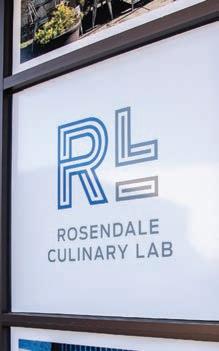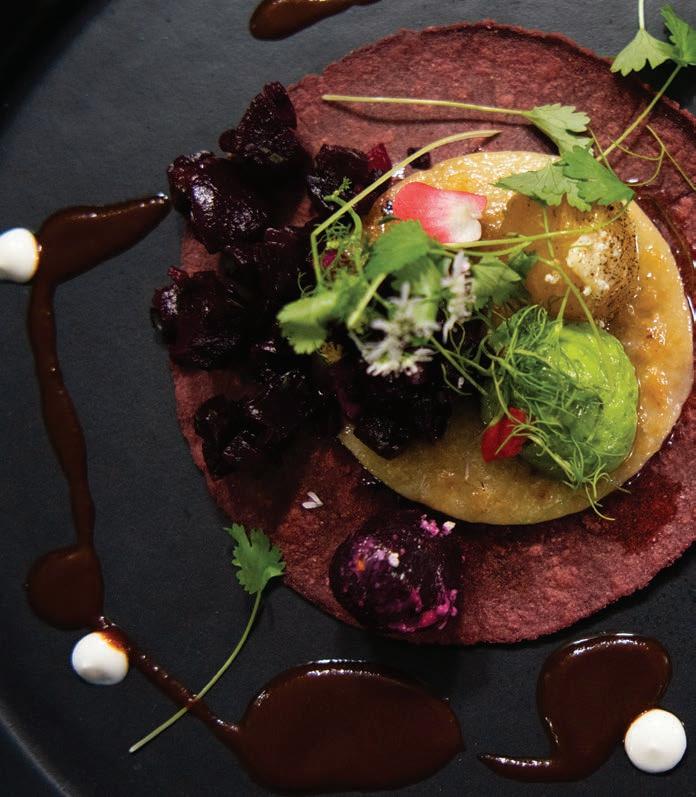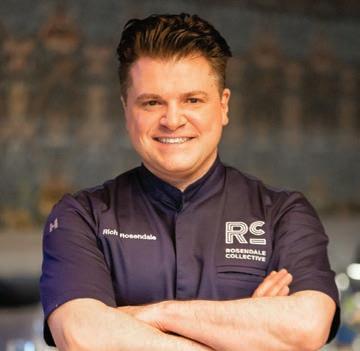
5 minute read
National Culinary Review Nov/Dec 2023
from National Culinary Review Nov/Dec 2023
by National Culinary Review (an American Culinary Federation publication)
DISSECTING THE DISH
How one ACF Chef thinks through high-volume, fine-dining plating // By Amelia Levin

ACF Chef Rich Rosendale, CMC, owner of Rosendale Collective, was invited to speak at the Roots conference held this fall at Farmer Lee Jones’ The Chef’s Garden and Culinary Vegetable Institute in Ohio, where chefs, farmers, purveyors, food writers and documentary producers from around the country came together to talk about regenerative agriculture and the future of the restaurant industry. For a vegetable-forward, eight-course farm dinner on the second night of the conference, Chef Rosendale served this smoked beet and brisket taco (pictured). Sounds straightforward, right? Wrong.
This dish and its various components took several days to conceptualize, plan, cook, properly pack and transport. Because so much was done ahead of time, Chef Rosendale — with two tightly packed cooler boxes in tow — needed only a sous vide machine, extra-strong blow torch and 30 minutes to retherm and prep all the plates for the 140-person dinner, which brought no less than 25 chefs under one tent outdoors with limited space and electricity. One would expect nothing less from a Master ACF Chef, successful restaurateur, entrepreneur and seasoned competitor who has competed on the ACF Culinary Team USA and had just returned from Bocuse d’Or tryouts.
Chef Rosendale worked closely with his head of R&D, Chef Miguel Contreras, and leaned on his state-of-the-art equipment at the RC Culinary Lab, a 4,000-square-foot production kitchen in Leesburg, Virginia, supporting the restaurant group’s various restaurants, catering operations, special dinners and events around the country, along with the RC wholesale and retail product lines. Everything from the tortillas to the mole sauces to the cheese, brisket, purees and beets was prepared days in advance and

ACF Chef Rich Rosendale, CMC, owns Roots 657, in Leesburg, Virginia, and R3 in Atlanta as well as a catering business, culinary school and Rosendale Culinary Lab, where he and his team conduct daily R&D and fulfill orders for Rosendale Online; Opposite: Chef Rosendale’s Smoked Beet and Brisket Taco served during the Roots conference at The Chef’s Garden in Ohio (Credit: Michelle Demuth-Bibb/The Chef’s Garden).
put in a blast chiller to quickly preserve the product without producing any ice crystals and to get it ready for packing in cooler boxes that were transported directly on the plane.
In addition to the carefully thought-out prep work, once on site, the actual plate selection proved important, too. Out of a generous offering of plateware provided by Steelite and Singer Equipment Co., Chef Rosendale’s team carefully selected ridged plates “with a lip” for extra stackability. This way, the team was able to at least get some of the elements down on the plate, including the tortilla, cheese and sour cream droplets and then stack them up to 10 plates high to start the plating process. Without this particular plate, for plating, “we would have needed way more people, and it would have taken way more time,” Chef Rosendale says. After just a quick torch of the tortilla and cheese, the other elements could be quickly added and slid down the line for service. Even the microgreens were pre-portioned into little cups for easy plating with tweezers.
“These are the tricks and things we try to think about when plating for high-volume events,” says Chef Rosendale. “We have a Raiders game coming up where we’ll be serving over 1,000 people outside at stations. Organization is a really big part of our planning. We’re a little unorthodox for a restaurant group in that we’re doing R&D all the time.”
BRISKET
“We wanted to offer some meat but do it in a way that still put beets at the center of the dish. We did an 18-hour smoked brisket in our smoker at the lab with various spices and then blast-chilled the meat into packs so they were almost like cooler packs in the shipping boxes. They just needed a sous-vide bath to bring to temperature on site.”
BEET-CO DE GALLO
“This is a play on pico de gallo — we rolled whole beets in a mixture of salt, soybean oil, water and AP flour, which helps draw out all the moisture when roasting at 375°F for a concentrated beet flavor and dark, rich color.”
CHEESE
“We made a cheese-based ‘dough’ with egg yolks, parmesan, gruyere and crème fraiche that we spread into sheets, cut into rings, blastchilled and vacuum-packed so that when it was time to plate, we could just torch the entire tortilla with the cheese and it would melt nicely but stay perfect in the shape of a ring and not run all over the place.”
ELOTE-STYLE ROASTED BEETS
“We took golden white beets sent to us from The Chef’s Garden, roasted them in the oven and scooped them into little spheres that we brushed with mayo on the outside to get the cotija cheese to stick, and we added a dusting of Tajin spice and corn husk ash.”
MOLE
“We prepared a traditional mole with chiles, spices and aromatics that we finished with chocolate and some more of the beet juice just to thin it down a little.”
TORTILLA
“We made a beet tortilla by dehydrating beet powder worked into traditional tortilla dough with a little brisket tallow added for malleability.”
SOUR CREAM
“We could have just added drops of sour cream, but after 30 minutes or so you might have water running out of it, so instead we added a little xanthan gum and champagne vinegar to the sour cream for a more shelf-stable mixture that we added to an ISO charger.”
MICROGREENS
“We were able to pick various microgreens from the greenhouse when we arrived at The Chef’s Garden — we chose coriander bloom, micro cumin and begonia and citrus marigold flowers for the garnish.”
AVOCADO ESPUMA
“We pureed avocado with yogurt, milk, sugar, salt, vegetable stock, dill and parsley and added that to an ISI whipping canister with two charges that we aerated for the plate.”







